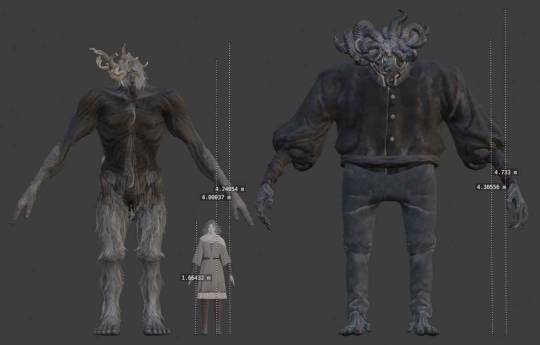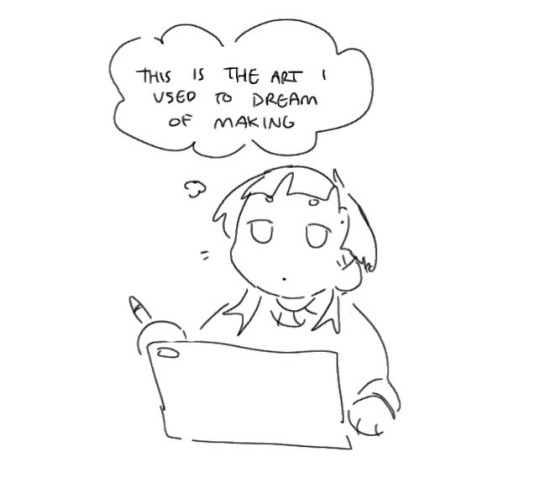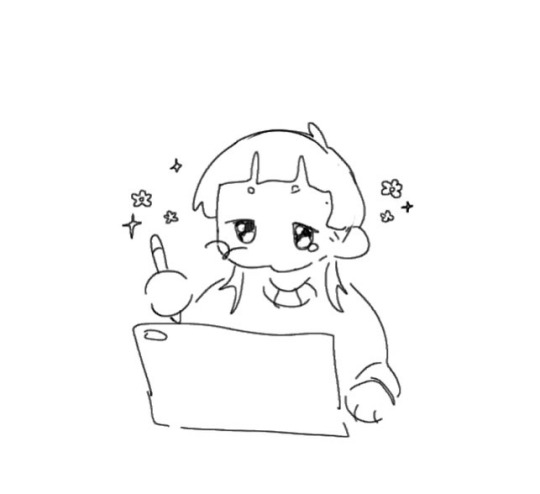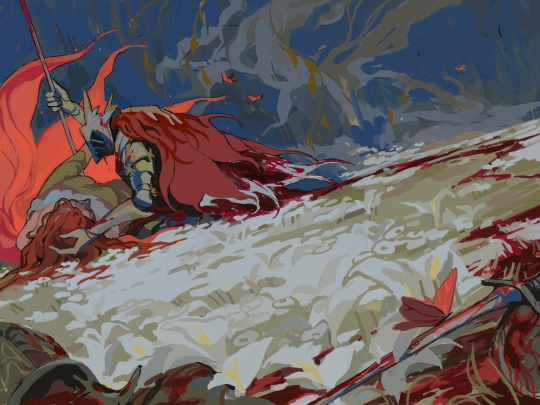Don't wanna be here? Send us removal request.
Text
Having internet friends is an experience. Did you eat today? I can’t believe your sister hasn’t apologized yet, what a bitch. Drink a glass of water right now. Want to see a cat picture? I love you. I know you better than your parents. I don’t know your name. I’m having a rough day, can you talk to me about your favorite videogame? I love you. Good morning means good night means good afternoon means go to sleep. Here’s a doodle I made in class. I’m stealing your clothes as we speak, they’re so pretty. I love you. I love your pet. What does your hair look like? I’d love to see that weird leaf. I love you. I’m making you your favorite food. Thank you for holding my secrets for me. I love you. We’re having a coffe date. I love you. I’m giving you a screen-sized hug. I love you. I love you. I love you.
115K notes
·
View notes
Text

Yay
I did it, finally made some hwfwm art I’m happy with! All it took was procrastinating several final projects/exams…
93 notes
·
View notes
Text
I was just talking to a friend of mine who still playing the DLC and I fucking was struck by a fucking galaxy brain theory
Remember good 'ol tragic Millicent? Remember her whole thing was that she was one of 5 "offshoots" that were born when Malenia did the big no fuck u to Radahn and fucked up Caelid?
Remember how at some point Milli says the following?
"There is something I must return to Malenia. The will that was once her own. The dignity, the sense of self, that allowed her to resist the call of the scarlet rot. The pride she abandoned, to meet Radahn's measure."
What if she meant that literally? That she literally is Malenia's dignity?
Shadow of the Erdtree is all about Miquella going around and shedding aspects of himself, fear love doubt and so on. Most people agree that St. Trina is the human manifestation of Miquella's love, so what if Millicent was the same?
Millicent is the human manifestation of Malenia's pride, and she was shed, just like Trina, when Mal decided to play dirty because she wanted to win at any cost
That includes Milli's sisters, I bet you they too are also aspects of Malenia's self, and when you fight her at the Haligtree, what you are actually fighting is a husk, a hallow imitation of what she used to be
Thats why she seems so out of it, she just wants to fight and win, thats all thats left of her :(
Milli wanted to return to Mal and merge back together, even if she didn't truly understand thats what she wanted, but alas she couldn't make it and Malenia was doomed to remain a husk of herself untill the very end
963 notes
·
View notes
Text
the usage of different types of english in elden ring
most human/tarnished NPCs we meet, like rogier, ansbach, and nepheli, use late modern english:
"a sorcerer, as you might have guessed. i'm looking for a little something, here in the castle. when i'm not hotfooting it from the troops, that is." - rogier, first meeting "general radahn. a pleasure to see you, after all this time. but those remains do not belong to you." - ansbach, upon summon for PCR
but older demigods like messmer, ranni, and morgott use early modern english:
"thou'rt tarnished, it seemeth. mother, wouldst thou truly lordship sanction, in one so bereft of light? yet… my purpose standeth unchanged." - messmer, pre-battle cutscene "thou needst not indulge them unduly, but they too wish to appraise thy worth. it hath been a passing long time since a newcomer entered my service, after all." - ranni, after agreeing to serve her
then there are the younger demigods, like miquella, malenia, and potentially melina, who use a later variant of modern english, similar to the tarnished NPCs we speak to:
"if we honour our part of the vow, promise me you'll be my consort. i'll make the world a gentler place." - miquella, post-PCR cutscene "the scarlet bloom flowers once more. you will witness true horror. now, rot!" - malenia, phase 2 transition cutscene
finally, the hornsent NPCs like the hornsent, hornsent grandam, and the hornsent spirits such as the one outside the whipping hut, who use late middle english similar to the english found in shakespeare's sonnets:
"fie, another? ... then, as that woman would surely say, we are in our purposes well aligned. but understand. your kind are not forgiven. the erdtree is my people's enemy. by marika long betray'd, set aflame." - hornsent, first meeting "all your resentment lingers yet... the raw stuff from which i shall surely forge a curse. upon the dastard messmer's head. upon marika's children each and all." - scorched ruins hornsent spirit
i find it interesting how different the usage of english is in the game, and i feel that it can be a hint on how to properly date an individual's occupation in the lands between/land of shadow. the hornsent, being a people much older than many in the lands between, use the most archaic version of english, while the tarnished and younger demigods use a form of english more closely related to our own in the current period. older demigods (and marika herself, as heard from melina's recounts of marika's spoken echoes) use a form of english more closely related to the period of transition from middle english to early modern english.
additionally, another interesting thing to me: mohg is almost certainly nearly the same age as morgott (since they're referred to as twins), yet he speaks a little differently compared to morgott:
"tarnished, thou'rt but a fool." - morgott, post-battle dialogue "dearest miquella. you must abide alone a while." - mohg, pre-battle cutscene
this makes me wonder if it's possible that, assuming that miquella's verbiage is indicative of his younger age in comparison to the older demigods (aka the demigods born before the marika/radagon union), miquella's charm altered mohg's perception enough to also alter his manner of speaking and carrying himself in some way. if his pursuit of finery (dressing in embroidered robes and handling himself with poise, juxtaposing his bestial growls and strength) was mainly done in an effort to fit into miquella's ideal of a consort. of course, mohg could just be as vain as he seems to be all on his own accord, but i find that it's interesting to entertain the idea that even his current state of being was due to miquella's charm.
i'd love to hear what others think about this. i'm not very learned when it comes to english (it's not really my first language), but i find this all very cool to think about.
1K notes
·
View notes
Text






Some more D/Rogier shitposts. I'm normal about them
180 notes
·
View notes
Text






Some more D/Rogier shitposts. I'm normal about them
180 notes
·
View notes
Text
In the absence of guidance of golden grace, there's guidance in death.
There's a lot of death symbolism around Messmer that, in a first moment, didn't get my attention, until I saw the skull on his own armor, hidden inside his cloak and, even in the second phase, hidden by a snake, as if it was some sort of a remind he keeps to himself. It is a detail made for him to guard, not for us to see. And despite it being a sad reminder, it can bring comfort.
The Tibia Mariner's boats is everywhere to be seen at Shadow Keep. They all burn with a golden flame to evoke the Grace they've lost once Marika abandoned them.

And it's easy to deduce why they are there: it's a funeral homage, a rite of passage for those who perished fighting the Crusades. All the soldiers that died fighting that holy war and their only reward was death.
Once the Lands of Shadow was sealed, they knew they would never return home. It's said even the nobles knights that sworn loyalty to Messmer were abandoned by their own houses. A spirit, once we kill the golden hyppo, refuses to believe the undeniable truth: they were abandoned both by Grace and Marika. They were left to die alone and death is all they can expect in those lands.
But there's guidance in Death. Now it does.
The Tibia Mariner's summons says: "The dead have long been left to wander. What they need is leadership." For ages, the dead lacked the leadership and, therefore, the guidance of said leader. Until now. They have a Prince to call their own.
And it's Messmer's brother. And he knows it. Because he buried the brothers-in-arms he cared the most, despite their rebellion against him, within the same catacombs where his brother's corpse grew.
Because Messmer knew the Prince of Death would guide his men in death. They would no longer be left to wander as they were in Lands of Shadows, forsaken and alone. They would have someone to watch over them, to guide them. And it's his very brother.
Which makes me think that even the flooded part of Shadow Keep holds a similar meaning. Death is strictly connected to water. We have the boats seeking a path to cross. We have the Prince with fish features residing in water. Death resides in water. And we, as player, must drain the water to explore the structure. We find a Marika statue submerged. They flooded the castle not only because its safer, but to keep death close.
As a reminder, as a guidance.

And that's why Messmer has a skull hidden in his clothes. To remind himself that his only path is death. There's nothing more waiting for him but death, that comes with us, the tarnished. But, at least, in death there's a comfort. In death, he wouldn't be alone or forsaken. There is somone he knows. There's family. There's comfort in death. His brother is there.
172 notes
·
View notes
Text
tarnished who gets adopted by rennala after becoming elden lord. tarnished who is actual family to the demigods after being rebirthed. tarnished who lives with rennala and her sweetings and takes care of them while having a mother to feel worth after spending their life just "saving" the lands between and becoming elden lord. tarnished who reunites the demigods and
48 notes
·
View notes
Text

Lore accurate to them i think
Ty for the best boy Ansbach in the collab @anorlondos ^^
Og meme pic v

2K notes
·
View notes
Text
the not-insignificant differences between the omen twins
so, i saw this picture posted by @amanaci which inspired me to write this rather lengthy piece on the contrasts between morgott and mohg. i decided that, instead of dumping this whole think-piece on their post, i'd make my own separate post and ramble here.

this difference in their height really tracks for how their fighting styles and personalities are like, i feel. i always found it peculiar how different they are despite being twins; i feel like there's a rather stark resemblance between miquella and malenia in their soft-faced features, pale skin, and long flowing hair, and a close resemblance between the carian siblings with their red hair, but morgott and mohg are rather different from each other, only bearing similarities due to their omen nature. i looked a little bit into that and found that there's pretty good reasons behind why.
firstly, morgott is severely malnourished and unhealthy in comparison to mohg. you can see it in his body and how his skin sags, how his ribs and bones show, and how dry it looks. below is a comparison between his hands and mohg's hands.


morgott's hands are dry, almost rubbed red and raw around the knuckles and fingers. it reminds me a little of psoriasis, or some kind of skin discolouration caused by his poor health. it's likely he isn't eating well, or at the very least, he isn't eating as well as mohg. his twin, on the other hand (ha!), has shiny, veiny skin with a healthy colour and gleam to them. it's like he wants to call to attention how well moisturised he is (which, in this case, compared to morgott, he is).


above is a comparison between the twins' horns. the difference is extremely evident to me; morgott's horns are dry, almost seeming brittle, like sun-dried bone that hasn't seen rain or moisture in years. it reminds me of the horns of a very neglected ram, almost, but despite that, the horn growths seem more controlled, less like the wild growths all over the royal omens of the shunning grounds and more controlled as a sort of jutting crown from mainly one side of his head. meanwhile, mohg's horns are shiny, curling wildly to the point of injury, taking his eye in its path of growth. they grew wildly enough to replace his hair altogether, if he ever had any, and give him an even more imposing silhouette with a literal crown of horns (and a beard to boot). beyond this, his horns look healthy, with clearly defined rings to each growth that shine under the light, much like the rest of him. he's oiled leather to morgott's dry hide.

another somewhat interesting detail of morgott is his tail. i know a lot of people see it as soft, and it certainly looks the part, but what i find interesting are two things: the first being that his fur looks quite matted in some lightings and angles but overall looks soft to the touch, and the second being that his tail's horns look much healthier than his own horns on his head. this is in clear contrast to the rest of his body, which looks dry and unassuming with smatterings of coarse white hair up and down his body, and i believe its a matter of the limits to his own self-care. he utilises his tail as another weapon in his arsenal, so he cares for it that it might serve him well in battle, unlike his head of horns, which only serve as a detriment to him with how they must obscure some of his vision, if not most of it. additionally, he likely could bear to look at his tail and care for it, but for an omen that hates his nature more than the average, he probably doesn't enjoy looking at his own face in the mirror enough to properly care for himself.

which brings me back to the sheer differences between these two. morgott, unhealthy and self-loathing, neglects many visual aspects of himself likely because he sees vanity as a luxury not afforded to someone like him. mohg, healthy and self-obsessed, cares and grooms himself to appear very much so like the lord he claims to be, loving himself to a heretical extreme (in the eyes of the golden order). their statures reflect this too; morgott hunches low to the ground, ready to pounce at any given moment but also due to his own shame and humility, while mohg stands tall and proud, though not as tall as he could possibly be due to his upbringing being one of likely having to hunch low to fit beneath the ceilings of the smaller parts of the shunning grounds.

above is a picture of an omen from stormveil, which bears resemblance to all the omen you see in the game. in terms of clothing, one of the big ways people set the omen twins apart, morgott is completely naked save for the ragged cloak of animal hides he wears, signifying he is not fit to even dress himself in a shirt or trousers as befits a king, much like the omen pictured. he wears even less than that, actually, since he lacks even the slightest adornment save for the rope that clasps his cloak together. on the other hand, mohg is entirely adorned in finery, wearing a beautifully embroidered, fashionable priest's robe with matching vestments, and beneath that (as seen in the first image) some underclothes, a plain black button up and some pants. mohg's entire silhouette changes with the removal of his robe, while morgott's barely makes an impact once you realise he has only taken off the one article of clothing he had.
then, of course, there are their fighting styles. there's this fantastic video on youtube that i recommend watching of the twins fighting every major boss in the game, and you can clearly tell them apart from their fighting styles alone. morgott is fast, his size making him look deceptively slow only for him to dart out and do sick flips and somersaults and pirouettes that rival even the most flexible dancers, and he fights with speed and almost animalistic ferocity, save for when he conjures his weapon incantations. mohg is slow but strong, capable of swinging that large trident around like it weighs nothing while hitting with the force to knock down most enemies in a few hits, and most tarnished in just one, but he fights with a steady gracefulness in his every move, walking slowly and carefully while casting spells that hurt a lot.
even their phase 2 transitions are markedly different, with morgott's being one where he drops to his knees, vomits, and releases his cursed blood(?) all over the battlefield, causing his weapon to become alight with his curse and for him to fight with more in-your-face aggression, and with mohg's being one where he simply ignores your attacks and begins stabbing his spear into the formless mother for power at your expense, gaining a majestic set of wings that put distance between you and him so he can cast more of his spells at safer distances. where morgott is pushed to his limit and forced to confront his nature, mohg has long since embraced it and enjoys the fruits of his bloody labour with the mother of truth's blessing.
speaking of the mother of truth, even their patron orders are at odds with each other. the golden order was built upon the foundation of a very carefully-guarded lie: that marika is the one true god, which she can't be, with the existence of radagon (as per goldmask, perhaps the number 1 fundamentalist we meet in game). the formless mother is known also as the mother of truth, existing in direct opposition of the golden order's lies and craving the honesty of one of the purest expressions of life: blood. these two ideals would war against each other, with one being dedicated to the upholding of a beautiful, corrupt lie and the other being dedicated to the instillation of a dynasty of raw, pure truths. as such, even morgott and mohg's own great runes reflect these contrasts in faith, though, remarkably, these two great runes are ones that fit perfectly over each other, with mohg's slightly elevated (seen below, taken from the fextralife wiki).



so, where does this leave us? i don't know, exactly. i wasn't really writing this with any sort of ultimate conclusion. i just found it really interesting how different they were, and i wanted to talk about all the noticeable, significant differences between them here. thanks for coming to my ted talk.
636 notes
·
View notes











